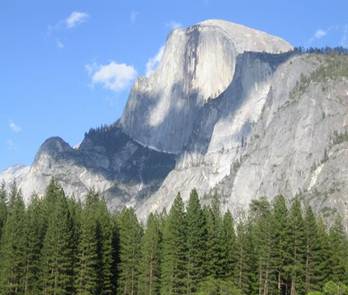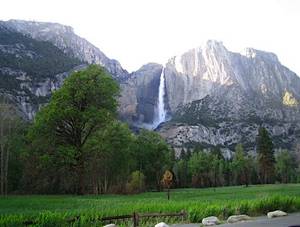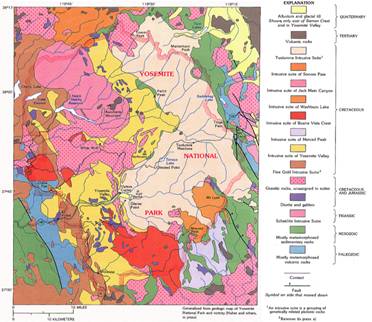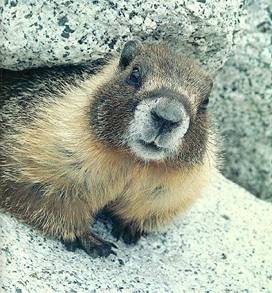Geology and Natural Heritage of the Long Valley Caldera
Yosemite National Park:
The Kingdom of Granite and Glaciers
Lauren Tourville
Abstract
Yosemite is a glacial landscape, covered with granite rock and vegetation. Glaciers from the Sherwin glaciation formed many of the landforms such as the valleys, domes, and created waterfalls and lakes. Polished granite has become one of the key characteristics that make much of the rock look like it has been weathered, but it is actually due to the glaciers flowing over the rock. There is also an abundant amount of wildlife in the area, like black bears and marmots. The vegetation can vary from almost desert-like to deeply wooded forests on the mountains. Yosemite is a treasure to our country and through preservation and consideration for its fragility its beauty will be able to be seen for another 200 million years.
During the Precambrian time period the Pacific plate was moving east and subducting under the North American continental plate, forcing a subduction zone in what we call today, California . When these rocks that made up the seafloor subducted below the continental plate they were heated up from the magma below the surface which became more exposed from this process. The rock melted and chains of volcanoes appeared in the area, creating molten volcanic rock deep below the surface. The plate movement exposed the granite during the formation on the Basin and Range region and the uplift of the mountain began. This volcanic rock is seen so frequently around this old plate boundary because long before that movement occurred plutonic granite was concealed under the surface, waiting for the tectonic movement to expose it. This occurred about 200 million years ago, and this tectonic movement is responsible for the beauty that people all over the world experience when they visit Yosemite National Park .
Yosemite is one of the most beautiful areas in the Basin and Range region not only because of the uplift of the mountains and exposure of granite, but also because glacial cover three million years ago completely morphed the landscape and made Yosemite the “ Incomparable Valley ”. (Huber, 1987) There are huge granite domes, some peaking over 3,000 feet; for example El Capitan , waterfalls that drop for hundreds of feet into deep lush river valleys, and polished cliffs surrounding glacial lakes. The whole valley is only seven miles long and one mile across, but within its boundaries it is such a diverse habitat, in a geological and natural aspect.
The National Park Service stated that the Park was home to Native Americans thousands of years before non-Indians ever ventured into the area. During the gold rush many miners flocked to the Sierras for its rich minerals, and that is when conflict erupted between the settlers and the Natives of the region. The conflict escalated into war and the in 1851 the Mariposa Battalion, which was organized by the state of California to prevent war, stumbled upon Yosemite while looking for natives on March 27 th of that year. After that Yosemite began attracting many settlers into the valley, quickly destroying the ecosystem. James Hutchings was one the first people to turn Yosemite into a tourist attraction, building hotels and bringing in tourists who would awe at the beauty of Yosemite Valley . Since the valley was seeing so much disturbance from construction and settlers moving into the area in 1864 President Abraham Lincoln set aside the valley as an “inalienable public trust”, allowing Yosemite to be preserved and protected. When John Muir began his exploration of the Sierras and started pushing for preservation of the region the state took notice of Yosemite and on October 1, 1890 it was established as a national park. Once the early 1900's rolled around and automobiles were invented Yosemite 's popularity increased and so did the number of visitors. Now Yosemite has been visited by millions of people from all around the world. (NPS.com)
The basic geology of Yosemite is similar to most of the Sierra Nevada region, but the valley is so special because of the glacial period which covered the area and morphed the topography. Glaciers are formed when snow is repeatedly accumulated and melted over the years and pressure from the top layers compresses the snow into glacial ice. They form in mountains because of the high elevation and heavy snowfall, and provide a passage through the valleys to let them flow almost like a stream down the mountain sides (Wikipedia). Yosemite was covered by at least three major glaciations. The major glaciation which carved out the Merced River canyon was the Sherwin glaciation. This was one of the biggest glaciations the Sierra Nevadas had ever seen, lasting for 300 thousand years, coming to an end about one million years ago. A glacier from this period is most definitely responsible for most of the valley's carved landscape, but other glaciations later on have also added to Yosemite 's unique geology. The two other glaciations that presumably passed through Yosemite were the Tahoe and Tioga, but neither of these was as massive and filled the valley a s the Sherwin glaciation.
U-shaped valleys, arêtes, moraines, and cirques are all infamously associated with glaciers and reasons people flock to Yosemite Valley . These landforms can be found throughout the park, giving everything a different look. In Huber's Geologic Story of Yosemite he describes many of these landforms and their role in Yosemite 's geology. U-shaped valleys are common throughout the park, and at their original creation were V-shaped until glaciers came through and rounded them out when they flowed through and carved the sides. These valleys are shaped in this way because glaciers, instead of flowing water, carve a straighter path throughout the valley instead of meandering, leaving the U-shape. Since the glaciers have a much larger force of pressure on the valleys they become smoothed out unlike water which changes levels and leaves rough edges along the sides of a valley.
U-Shaped Valley, Yosemite. Figure reproduced by Bell , et al. [2008]
Another landform, which is caused by glacial activity in a U-shaped valley , is an arête, which is thin, rough ridge along the sides of the valley. This is seen when there are two of these glacial valleys next to each other and the ridge is created from their extreme weathering. There is also another way which arêtes can be formed through weathering processes, except this is “when two cirques erode head wards towards each other” (Wikipedia). A crique is an amphitheater-like valley at the head of a glacier and it is the send off point of the glacier. Once the glacier has flowed out of the cirque there are often lakes that remain and fill up the valley. While driving into Yosemite National Park there are many cirques seen throughout Tioga Pass , and throughout the park.
Many Landforms in the Park are known worldwide, like Half Dome, El Capitan, Bridalveil Falls , and Tuolumne Meadows. Each of these have become such a great geologic history to them which is why people come from all over to awe in their splendor. Half Dome is one of the many large granite monoliths that Yosemite is renowned for. These massive granite structures were created when magma was intruded into an older host rock beneath the surface until they repeated this process, for up to 130 million years until they became a huge pluton. After weathering took its tool on the surrounding rock these monoliths were exposed at the surface leaving the massive domes that appear around Yosemite Valley , like Half Dome. These domes have both a steep, almost 90 degree side to them, and a gently sloping side. The steep side of the dome was created through sheet jointing within the monolith. What happens is the fracture that runs through the granite moves towards rock that has been eroded and is not as strong as the rock towards the interior, and then it breaks in a sheet-like way to flatten one side of the dome. The other side of the dome is smooth and has a very low gradient because it is gently being weathered down by the elements. The rounding is also a glacial effect, and along these surfaces is one of the most amazing characteristics of glacial erosion, polished granite. When the sun hits the side of a mountain in Yosemite the rock shines as if it were wet or covered in a glossy substance. The rock appears this way because of how glaciers flowed across it and smoothed the exposed granite to a smooth finish. Spotted all across this smooth granite are pebble-sized feldspar crystals which are weathering away slower than the surrounding rock.
Half Dome. Figure reproduced by Valliant, et al. [2008]
El Capitan is another landform which has become one of the best places in the world for skilled rock climbers to test their abilities. This rock has much more to it than a good climbing wall; there are different types of volcanic extrusions which have given this rock its beautiful exterior. Gabbro is the darker rock that is seen in small parts of the sheer walls, and so is Taft Granite, mostly visible at the top of the structure. These other volcanic rocks were formed by intrusions. Much of the gabbro is in vein-like patterns, showing the openings it flowed into within the other granite. Another feature which has also been the result of glacial forces is the Cathedral Peak , which was also an intrusion, but it lies very high in the mountains, the peak towering above Yosemite . It comes to a point at the top where it was not exposed to erosion by the glaciers. This landmark is also another very popular place for rock climbers to test themselves on the polished granite walls.
Glaciers were not the only force responsible for many of the beautiful landmarks of Yosemite . Bridalveil Falls , a 620-foot vertical waterfall which pours down the side of a granite face. Many of the waterfalls have a v-like shape at their pouring point, which is due to erosion of the rock from water for many years. Other waterfalls are called “hanging valleys” and used to be the mouth of glaciers feeding into the valley below. An example of this in the park is Yosemite Falls . The water comes from glacial lakes and streams which pour over the sides of the valleys, draining into the rivers, such as the Merced River . The Merced River which flows through the valley many has some erosional elements by transporting rocks down the valley, but the valley's main erosional force is the glaciers that ran through it long ago. Within these valleys large meadows are created from the glaciers' flowing movement. Tuolumne Meadows is a great vast plain which was once covered by a glacier. Now streams run through it and it has become a habitat for many animals and plant-life. Beyond Tuolumne Meadows, Tenaya Lake appears a huge lake sitting beautifully below huge granite walls. The valley this lake sits in was formed by a glacier, then once it melted the water was left over, and Tenaya Lake was created.
Yosemite Falls. Figure Reproduced by Valliant, et al. [2008]
Any geologic map will show an array of colors, and a map of Yosemite is not any different. By looking at a very specific geologic map provided by the USGS (couldn't be shown here because of its size) most of the rocks that lay on the ground of Yosemite National Park are some type of granite bedrock, which was formed mostly during the Cretaceous period. The light pink color that makes up most of the Eastern part of the park is medium-grained, intrusive granodiorite with large feldspar crystals. This rock is what is covering most of Tuolumne Meadows and the domes within it. This area is also covered by another rock type, formed during the Pleistocene period, called the Tioga Till. These rocks are surficial deposits and consist of glacial moraines. The salmon colored area is also a granitic rock, called the El Capitan granite. The El Capitan granite is course-grained and made up of light gray biotite granite and granodiorite. Much of this rock is seen on the large faces of rocks like El Capitan within Yosemite Valley , and the different types of intrusive volcanic rock can be seen in shades of blacks and grays. The light purple color is another type of granite, a course-grained, darker colored rock and is seen extensively throughout the area. The majority of the rock that makes up Yosemite is a granodioritic rock, some of the characteristics of the grain size and crystal faces differ but they are all similar in composition. The granite rocks in the park are all related to the Sierra Nevada batholith and come from the same volcanic eruptions as seen throughout the rest of the mountains.
Geologic Map, Yosemite. Figure reproduced by Google Images, et al. [2007]
Granite is not the only rock seen in the park; there are traces of metamorphic rocks also. On the Eastern border, where the formation of mountains was from pyroclastic flows instead of the intrusive granite that the rest of the area is notable for. While driving through the Tioga Pass these metamorphic rocks can be seen, and they have a different appearance than the rest of the area which is covered in Granite. This rock was laid during the Paleozoic time, and the bedrock, which was pressurized and heated, was mainly sandstone, siltstone, and limestone, which the mountains are composed of, and they have a different, more light-brown or even orange-like color to them. They also look different because they do not appear to have that glossy look of the granite surfaces due to the glacial polish. Another surficial deposit seen in parts of the region is colored as yellow in the map. It is called Alluvium and comes from the Holocene period. Alluvium is the deposits from mountain streams, which have created alluvial fans, and glacial outwash deposits. This type of rock is seen in large valleys and upland meadows, where the streams left their deposits.
There is much more than just rocks that make Yosemite such a special place; the wildlife here is so diverse and isolated from much of the world. There are 150 species of birds that are regular in the park and more than half of these of these birds are migratory and fly south during the winter (NPS.com). 84 of the 150 species of birds nest in Yosemite and come back every year to repeat this action. Some species of owls, willow flycatchers, and the white-tailed ptarmigan are a point of concern for the park officials because their species have been decreasing due to development, recreation, and harm from other species of birds, for example the brown-headed cowbirds. According to the National Parks Service the brown-headed cowbirds steal nests of other birds and lay their eggs, and then once they hatch the baby cowbirds push the other unhatched eggs out of the nest to their death. There are not only birds in Yosemite ; many types of mammals call this valley their home. Black bears are one of the most popular animals to spot in the park, but there have been many run-ins with humans that have resulted in injury or damage to property if they do not follow the Black Bear Awareness programs that the park has established. Other mammals that are frequently seen are mule deer and squirrels. Marmots are also seen all around the park, usually crawling around on rock faces. Marmots are large rodents and the ones that occupy Yosemite have become people friendly, due to the excessive feeding.
Marmot. Figure reproduced by Google Images
The plant life in Yosemite is also very diverse and much of the reason that all the wildlife flocks to this area, and people come to enjoy the scenery. According to the National Parks Service Yosemite ranges in elevation from 2,000 to 13,000 feet, and five different vegetation zones can be found within the park's boundaries. This ranges from alpine vegetation along the topmost peaks of the mountains all the way to chaparral meadows at low elevations. In the high elevations there are many subalpine coniferous forests which can withstand the cold and long winters. Lower than these forests the junipers and Jeffery pines are located, and provide many habitats for animals. Another tree that is found around the park is the great Sequoia groves, which grow very tall and are very old. These groves also have not only pine trees but fir trees and birches are present at this lower elevation forest. At an even lower elevation, the lowest Yosemite has, the climate is hot and doesn't receive much snow and this is where the shrubs and oak trees are found. They can't survive in the snowy high elevations, but these meadows make perfect habitats for these trees. Flowers also add to the beauty of Yosemite by painting the landscape with purples, reds, and yellows. Indian paintbrush, mule's ear, and blazing stars are all species of blooming flowers that can be found in the meadows and forests of the park.
Yosemite has created a sanctuary for geologists, artists, and thrill seekers to find their calling in this natural environment. There is such a long geologic history here that anyone could study the rocks in the park and find so much about them that is unknown. The mountains and valleys provide such a picturesque portrait that looks like it belongs on a canvas. Ansel Adams, a world famous black and white photographer, focused most of his work in Yosemite. For the other people who love to come to Yosemite to rock climb huge rock faces, swim in glacial lakes, and hike through hundreds of miles of trails, this is their Heaven. There is something for everyone to see or do in Yosemite, and the diversity of the geology and nature really makes Yosemite National Park the “ Incomparable Valley ” that Huber dubbed it.
Works Cited
The Geologic Story of Yosemite National Park , N. King Huber (1987). Yosemite Association (Reprint, 1989).
National Park Service Website , US Department of Interior. Yosemite. [2008] http://www.nps.gov/yose/
Wikipedia.org, Geology of the Yosemite Area, [2008] http://en.wikipedia.org/wiki/Geology_of_the_Yosemite_area
USGS Geologic Map, Yosemite National Park http://pubs.usgs.gov/imap/i1874/images/yose.gif




